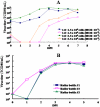Pilot scale production of highly efficacious and stable enterovirus 71 vaccine candidates
- PMID: 22529942
- PMCID: PMC3328501
- DOI: 10.1371/journal.pone.0034834
Pilot scale production of highly efficacious and stable enterovirus 71 vaccine candidates
Abstract
Background: Enterovirus 71 (EV71) has caused several epidemics of hand, foot and mouth diseases (HFMD) in Asia and now is being recognized as an important neurotropic virus. Effective medications and prophylactic vaccine against EV71 infection are urgently needed. Based on the success of inactivated poliovirus vaccine, a prototype chemically inactivated EV71 vaccine candidate has been developed and currently in human phase 1 clinical trial.
Principal finding: In this report, we present the development of a serum-free cell-based EV71 vaccine. The optimization at each step of the manufacturing process was investigated, characterized and quantified. In the up-stream process development, different commercially available cell culture media either containing serum or serum-free was screened for cell growth and virus yield using the roller-bottle technology. VP-SFM serum-free medium was selected based on the Vero cell growth profile and EV71 virus production. After the up-stream processes (virus harvest, diafiltration and concentration), a combination of gel-filtration liquid chromatography and/or sucrose-gradient ultracentrifugation down-stream purification processes were investigated at a pilot scale of 40 liters each. Although the combination of chromatography and sucrose-gradient ultracentrifugation produced extremely pure EV71 infectious virus particles, the overall yield of vaccine was 7-10% as determined by a VP2-based quantitative ELISA. Using chromatography as the downstream purification, the virus yield was 30-43%. To retain the integrity of virus neutralization epitopes and the stability of the vaccine product, the best virus inactivation was found to be 0.025% formalin-treatment at 37 °C for 3 to 6 days. Furthermore, the formalin-inactivated virion vaccine candidate was found to be stable for >18 months at 4 °C and a microgram of viral proteins formulated with alum adjuvant could induce strong virus-neutralizing antibody responses in mice, rats, rabbits, and non-human primates.
Conclusion: These results provide valuable information supporting the current cell-based serum-free EV71 vaccine candidate going into human Phase I clinical trials.
Conflict of interest statement
Figures




References
-
- Ho M, Chen ER, Hsu KH, Wu SJT, Chen KT, et al. The Taiwan Enterovirus Epidemic Working Group. An epidemic of enterovirus 71 infection in Taiwan. N Engl J Med. 1999;341:929–935. - PubMed
-
- McMinn PC. An overview of the evolution of enterovirus 71 and its clinical and public health significance. FEMS Microbiol Rev. 2002;26:91–107. - PubMed
-
- Xu J, Qian Y, Wang S, Serrano JMG, Li W, et al. An emerging infectious disease vaccine target in the Far East? Vaccine. 2010 doi: 10.1016/j.vaccine.2010.03.003. - DOI - PubMed
-
- Lee MS, Chang LY. Development of enterovirus 71 vaccines. Expert Rev Vaccines. 2010;9:149–156. - PubMed
-
- Solomon T, Lewthwarte P, Perera D, Cordosa MJ, McMinn P, et al. Virology, epidemiology, pathogenesis and control of enterovirus 71. Lancet Infect Dis. 2010;10:778–90. - PubMed
Publication types
MeSH terms
Substances
LinkOut - more resources
Full Text Sources
Other Literature Sources

